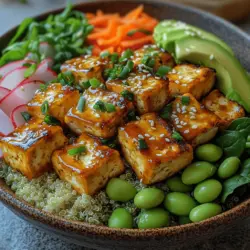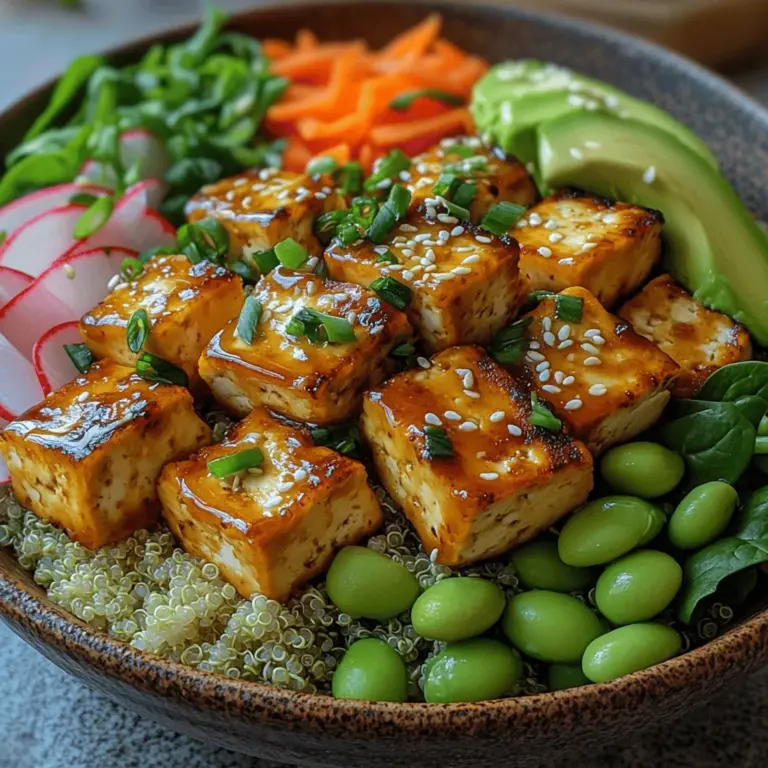Crispy Tofu Buddha Bowls: A Nutrient-Packed Delight
In recent years, Buddha bowls have surged in popularity, becoming a staple for those embracing a plant-based diet. These vibrant, visually appealing meals are not only satisfying but also incredibly versatile, allowing for a harmonious blend of flavors, textures, and nutrients all in one bowl. Among the myriad of Buddha bowl options, the crispy tofu Buddha bowl stands out as a delicious and nutritious choice, promising a feast for both the eyes and the palate.
The crispy tofu Buddha bowl is a delightful assembly of ingredients that come together to create a balanced meal. It features golden-brown, crisp tofu as the star protein, complemented by a rainbow of fresh vegetables, grains, and a luscious dressing that ties everything together. This recipe is not just about taste; it’s also about nourishment, making it an ideal meal for anyone looking to boost their health while enjoying vibrant flavors.
Understanding Buddha Bowls
Buddha bowls, often characterized by their colorful presentation and medley of ingredients, have roots that trace back to various cultural traditions. The term “Buddha bowl” itself is believed to have originated from the idea of a bowl filled to the brim, much like the rounded belly of a Buddha. These bowls are typically composed of a base (such as grains), a variety of fresh vegetables, a protein source, and a dressing, all artfully arranged to create a visually appealing meal.
At their core, Buddha bowls exemplify the concept of balanced meals. They offer a comprehensive array of nutrients, combining carbohydrates, proteins, and healthy fats in one dish. This makes them not only satisfying but also nourishing, ensuring that you receive a broad spectrum of vitamins and minerals with every bite. The beauty of Buddha bowls lies in their flexibility; you can customize them based on seasonal produce or personal preferences, ensuring you never tire of the same flavors.
Variety is key when it comes to the ingredients in a Buddha bowl. Each component contributes its unique set of nutrients, enhancing the overall health benefits of the meal. Incorporating different colors and textures not only makes the dish more appealing but also ensures a wide range of health-promoting properties.
Health Benefits of Key Ingredients
The crispy tofu Buddha bowl is a powerhouse of nutrition, thanks to its thoughtfully selected ingredients. Let’s delve into the health benefits of some of the key components that make this dish a nourishing choice.
Tofu
Tofu, often hailed as a staple in plant-based diets, serves as the protein foundation in this bowl. Made from soybeans, tofu is an excellent source of high-quality plant protein, providing essential amino acids necessary for muscle repair and growth. It is also low in calories and contains beneficial compounds such as isoflavones, which may help reduce the risk of certain diseases. Tofu is incredibly versatile; when cooked to a crispy finish, it adds a delightful texture that contrasts beautifully with the other components of the bowl.
Quinoa
Quinoa, frequently referred to as a superfood, is another key ingredient in this Buddha bowl. This ancient grain is unique in that it is a complete protein, containing all nine essential amino acids. Additionally, quinoa is rich in fiber, vitamins, and minerals, making it a heart-healthy option. Its nutty flavor and fluffy texture make it a perfect base for a variety of dishes, while also contributing to satiety.
Fresh Vegetables
The colorful assortment of fresh vegetables in the crispy tofu Buddha bowl not only enhances the visual appeal but also packs a nutritional punch. Red cabbage, for instance, is rich in antioxidants and vitamins C and K, while spinach provides iron and magnesium. Edamame adds a protein boost, and carrots are an excellent source of beta-carotene. Radishes provide a refreshing crunch, and creamy avocado contributes healthy fats that support heart health. Together, these vegetables create a symphony of flavors and textures that elevate the dish.
Sesame Seeds and Green Onions
Sesame seeds and green onions are often used as garnishes in Buddha bowls, but their benefits extend beyond mere decoration. Sesame seeds are rich in calcium, magnesium, and healthy fats, while their subtle nutty flavor enhances the overall taste of the dish. Green onions, on the other hand, add a fresh, mild onion flavor along with antioxidants and vitamins A and C.
Peanut Sauce
Finally, the peanut sauce that drizzles over the crispy tofu Buddha bowl not only adds a creamy richness but also brings additional nutritional benefits. Peanuts are a good source of protein and healthy fats, and the sauce can be tailored to meet various dietary needs—such as using almond butter for nut allergies or using coconut aminos instead of soy sauce for a gluten-free option.
Ingredients Breakdown
Creating a crispy tofu Buddha bowl requires a thoughtful selection of ingredients. Here’s a detailed breakdown of each component and its role in the recipe:
1. Tofu: Firm or extra-firm tofu works best for achieving that coveted crispiness. Pressing the tofu before cooking helps remove excess moisture, allowing it to brown beautifully.
2. Quinoa: Rinse and cook the quinoa according to package instructions. This grain serves as a nutritious base, providing fiber and protein.
3. Fresh Vegetables: Aim for a mix of colors and textures. Red cabbage, spinach, edamame, shredded carrots, sliced radishes, and diced avocado are excellent choices. Feel free to substitute with seasonal vegetables to keep things fresh.
4. Sesame Seeds and Green Onions: Use toasted sesame seeds for an extra layer of flavor and sprinkle finely chopped green onions over the bowl for freshness.
5. Peanut Sauce: A simple combination of peanut butter, soy sauce (or a gluten-free alternative), lime juice, and a touch of sweetness (honey or maple syrup) creates a delicious sauce that brings the bowl together. Adjust the consistency with water as needed.
In the next section, we will delve into the preparation of the crispy tofu, detailing the step-by-step process to achieve that perfect crunch that makes this dish irresistible. Whether you’re a seasoned cook or a beginner in the kitchen, this recipe will guide you through creating a beautiful, nourishing meal that celebrates the best of plant-based eating.
{{image_2}}
Importance of Properly Draining and Pressing Tofu for the Best Texture
When it comes to making crispy tofu, the foundation of your dish lies in the preparation of the tofu itself. Properly draining and pressing the tofu is crucial for achieving a desirable texture. Tofu is packed with water, which can prevent it from crisping up during cooking. To press tofu effectively, start by wrapping it in a clean kitchen towel or paper towels and placing a heavy object, such as a cast-iron skillet or a few cans, on top. Leave it for at least 30 minutes to an hour, allowing the excess moisture to escape. This step is essential; without it, your tofu may end up soggy rather than crispy.
Once you’ve pressed the tofu, cut it into your desired shape—cubes or slabs work well. The firmer the tofu, the better the texture will be after cooking. Firm or extra-firm tofu varieties are ideal, as they hold up well during the cooking process, providing that satisfying crunch that makes crispy tofu so enjoyable.
Explanation of the Cornstarch Coating and How It Contributes to Crispiness
After pressing your tofu, the next step is to create that coveted crispy exterior. One effective way to do this is by coating the tofu in cornstarch. This ingredient plays a pivotal role in achieving a crunchy texture. When you toss the pressed tofu cubes in cornstarch, it forms a light coating that crisps up beautifully when baked or fried.
To coat the tofu, place the cubes in a mixing bowl, sprinkle them generously with cornstarch, and toss until they are evenly coated. This simple step can make all the difference in the final texture of your dish. As the tofu cooks, the cornstarch absorbs moisture and forms a crispy crust, creating a delightful contrast with the soft interior of the tofu.
Baking Technique: Optimal Temperature and Timing for Achieving the Perfect Texture
Once your tofu is coated and ready for cooking, preheat your oven to 400°F (200°C). Baking at this temperature is ideal for achieving crispy tofu without the need for frying, making it a healthier option. Spread the cornstarch-coated tofu cubes in a single layer on a baking sheet lined with parchment paper. Ensure that the cubes have enough space between them; overcrowding the pan can lead to steaming rather than crisping.
Bake the tofu for about 25 to 30 minutes, flipping the cubes halfway through to ensure even cooking. You’ll know the tofu is ready when it’s golden brown and crispy on the outside. For an extra touch, you can broil the tofu for the last couple of minutes to enhance the crispiness, just be sure to watch it closely to avoid burning.
Cooking the Quinoa
Tips on Cooking Quinoa Perfectly
While the tofu is baking, it’s time to prepare the quinoa. Quinoa is a fantastic base for Buddha bowls, providing a hearty source of protein and fiber. To cook quinoa perfectly, start by rinsing it under cold water in a fine-mesh sieve. This step removes the saponins, a natural coating that can impart a bitter taste.
For every cup of quinoa, use a water-to-quinoa ratio of 2:1. So, for one cup of dry quinoa, you’ll need two cups of water or vegetable broth for added flavor. Bring the liquid to a boil, then add the rinsed quinoa, reduce the heat to low, and cover the pot. Allow the quinoa to simmer for about 15 minutes, or until all the liquid is absorbed. Remove from heat and let it sit for 5 minutes before fluffing it with a fork. This resting period allows the quinoa to steam and become even fluffier.
How Quinoa Complements the Other Ingredients in the Bowl
Quinoa not only adds texture to the Buddha bowl but also complements the crispy tofu and fresh vegetables beautifully. Its nutty flavor pairs well with the savory tofu and the vibrant tastes of the veggies. Additionally, quinoa is rich in essential amino acids, making it a complete protein source, which is particularly beneficial in plant-based diets.
Assembling the Buddha Bowls
Techniques for Visually Appealing Presentation
Assembling your Buddha bowls is where the creativity shines. Start with a base of fluffy quinoa and layer your ingredients aesthetically. A visually appealing presentation not only makes the dish more inviting but also enhances the dining experience. Consider using a large bowl or plate and arranging the components in sections rather than mixing everything together. This approach allows for color contrast and showcases the variety of ingredients used.
Suggestions for Layering Ingredients for Flavor and Texture
Begin with a generous scoop of quinoa at the bottom. Next, add your crispy tofu on one side, followed by an assortment of colorful vegetables such as cherry tomatoes, shredded carrots, and sliced cucumbers. For added nutrition and crunch, consider including ingredients like avocado slices, radishes, or leafy greens.
Drizzle your favorite dressing—such as tahini sauce, peanut dressing, or a tangy vinaigrette—over the top. Finish with a sprinkle of sesame seeds or chopped nuts for an extra layer of texture. This method not only enhances flavor but also provides a balanced bite with each forkful.
Tips on Customizing Bowls Based on Personal Preferences
One of the best aspects of Buddha bowls is their versatility. Feel free to customize your bowl according to your taste preferences or dietary needs. Swap quinoa for brown rice or farro if you prefer a different grain. Use seasonal vegetables, or add legumes like chickpeas or black beans for added protein. You can even experiment with different dressings and toppings to keep things exciting.
Serving Suggestions
Ideal Occasions for Serving Crispy Tofu Buddha Bowls
Crispy tofu Buddha bowls are perfect for a variety of occasions, from meal prep to family dinners. They make an excellent lunch option for work or school, as they can be prepared in advance and stored in the fridge. The vibrant colors and fresh ingredients make them an appealing dish for gatherings, potlucks, or even casual family meals.
Pairing Ideas with Beverages or Side Dishes
Pair your Buddha bowls with a refreshing beverage, such as iced herbal tea or a light white wine. For a more filling meal, consider serving it alongside a simple side salad or roasted vegetables. The combination will create a well-rounded dining experience that satisfies both hunger and taste.
How to Store Leftovers and Reheat for Optimal Taste
If you have leftovers, store the components separately to maintain freshness. Keep the crispy tofu in an airtight container in the refrigerator, and it should stay good for up to three days. When reheating, use an oven or toaster oven to restore its crispiness, rather than a microwave, which may make it soggy. The quinoa and vegetables can be reheated in the microwave for convenience, but remember to add a splash of water to the quinoa to keep it moist.
Nutritional Information
Overview of the Nutritional Profile per Serving
Crispy tofu Buddha bowls are not only delicious but also packed with nutrients. Each serving typically provides a good balance of macronutrients, including carbohydrates from quinoa, healthy fats from avocado or nuts, and protein from tofu. Depending on the vegetables added, you also gain a variety of vitamins and minerals.
Discussion on Macronutrients and Micronutrients Provided by This Dish
A typical serving might contain around 400-500 calories, with approximately 20-25 grams of protein, 40-50 grams of carbohydrates, and 15-20 grams of healthy fats. The dish is also a great source of fiber, which aids in digestion and helps maintain satiety. The colorful vegetables contribute antioxidants and micronutrients, such as vitamin C and potassium, promoting overall health.
Conclusion
Crispy tofu Buddha bowls are a delightful way to incorporate more plant-based meals into your diet while enjoying a range of flavors and textures. These bowls are not only visually appealing but also nutritionally balanced, making them an excellent choice for health-conscious eaters. The process of creating these bowls is flexible, encouraging you to experiment with different ingredients and flavors to suit your tastes.
As you embrace the joy of cooking with fresh vegetables, grains, and proteins, remember that the possibilities are endless. Don’t hesitate to try new combinations or dressings, and make this dish your own. By incorporating more plant-based meals like crispy tofu Buddha bowls into your daily routine, you’re taking a step toward a healthier lifestyle while enjoying delicious food.


